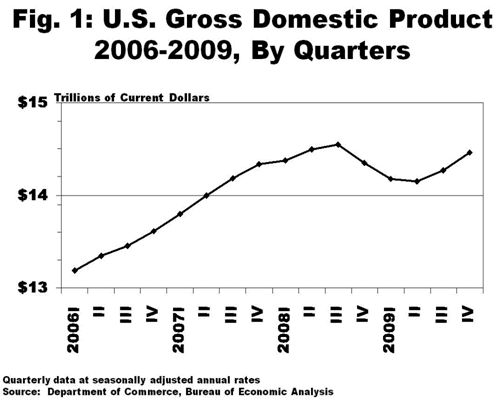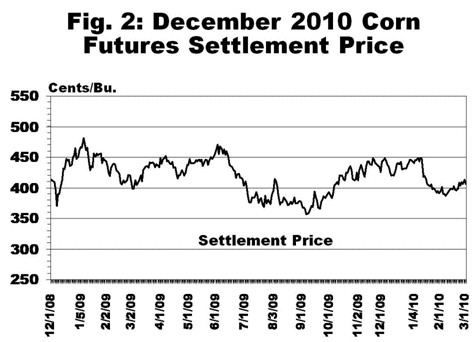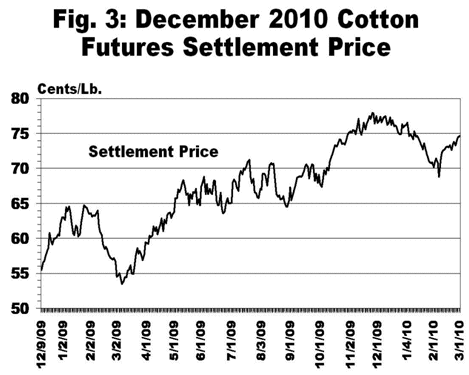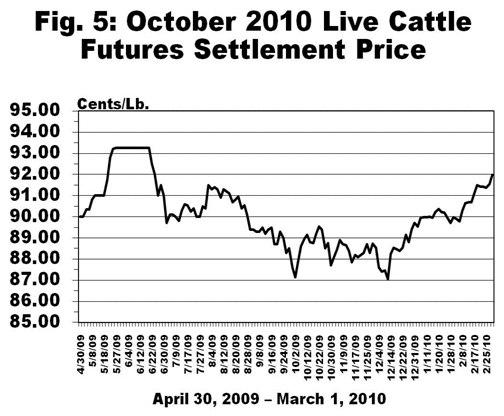Vol. 26, Issue 9, March 3, 2010 – PDF version
Jose G. Peña, Texas AgriLife Extension Economist-Management
Commodity and livestock prices are firming as the economy shows cautious signs of recovery. The estimate of the U.S. Gross Domestic Product (GDP) has been positive the past two quarters, a technical indicator that the U.S. recession is over (See Figure 1). However, high unemployment, depressed real estate markets, and credit concerns remain signs of economic weakness. An upturn in the global economy will increase demand for basic commodities and contribute to price strength for agriculture. USDA’s February 11, 2010 forecast of net farm income for 2010 of $63 billion is up $6.7 billion (11.8 percent) from 2009’s $56.4 billion, but down $1.5 billion (2.2 percent) from the $64.5 average of the previous ten years and down $24.1 billion from 2008’s record high net farm income of $87.1 billion.
 Also, USDA’s February 11, 2010 estimate of net cash farm income (income from projected cash transactions) at $76.3 billion is higher than the estimate of net farm income, indicating that the farm sector remains relatively solvent, but the accumulation of wealth, as measured by net farm income, remains relatively slow.
Also, USDA’s February 11, 2010 estimate of net cash farm income (income from projected cash transactions) at $76.3 billion is higher than the estimate of net farm income, indicating that the farm sector remains relatively solvent, but the accumulation of wealth, as measured by net farm income, remains relatively slow.
The increase in net farm income appears primarily attributable to expected improved prices for most commodities. Estimated total production expenses for 2010 are up slightly from 2009, but down $8.6 billion from 2008’s record high. It appears that the global recession placed downward pressure on not only commodity prices but on input expenditures as well, specifically fertilizer and feed.
Robust exports are important to sustain higher commodity prices. U.S. exports are supported by a weak dollar while a strong dollar is a trade impediment. A large federal deficit, increased money supply, and low interest rates to spur economic activity all contribute to a weak dollar.
For corn, we are still waiting for a definitive production number in 2009 due to harvest delays. It appears a wet spring will delay field preparation work in 2010 and planted acreage is uncertain. All this is contributing to higher corn prices. Futures prices for December 2010 corn contracts closed at $4.06/bushel on Monday (3/1/10), up $0.20/bushel from early February lows (See Figure 2).
 Cotton followed a very similar pattern. Futures prices for December 2010 contracts closed at 74.66 cents per pound on Monday (3/1/10), up about five cents from early February (See Figure 3).
Cotton followed a very similar pattern. Futures prices for December 2010 contracts closed at 74.66 cents per pound on Monday (3/1/10), up about five cents from early February (See Figure 3).
 The prospects for profits in 2010 for livestock producers have improved substantially after last year’s financially difficult year. The U.S. beef and dairy herd has shrunk to the lowest levels since 1951, helping to set the stage for lower beef and dairy supplies and a potential for higher prices.
The prospects for profits in 2010 for livestock producers have improved substantially after last year’s financially difficult year. The U.S. beef and dairy herd has shrunk to the lowest levels since 1951, helping to set the stage for lower beef and dairy supplies and a potential for higher prices.
USDA’s initial forecast of total net cash and net farm income for 2010 are up, but the largest forecast gains are in the livestock sector, partially attributable to lower feed costs, but also from expected market improvements. USDA’s initial forecast of total U.S. cash receipts for all crops at $160.3 billion is down $6.0 billion from $166.3 billion in 2009, compared to the estimate of total U.S. cash receipts from all livestock production which is estimated at $130.2, up $11.5 billion from $118.8 billion in 2009.
The cattle market remains strong. Prices for most feeder and live cattle futures contracts were up on Monday (3/1/10). October feeder cattle contracts closed at $105/cwt, up $7/cwt from late December 2009 lows of $98/cwt (See Figure 4).
 October live cattle contracts closed at $92/cwt, up five cents from mid-December lows of $87/cwt. While profits for slaughter cattle may be undercut by higher prices for calves and feeders, lower hedged feed costs may help return feedlots to profits (See Figure 5).
October live cattle contracts closed at $92/cwt, up five cents from mid-December lows of $87/cwt. While profits for slaughter cattle may be undercut by higher prices for calves and feeders, lower hedged feed costs may help return feedlots to profits (See Figure 5).
 Appreciation is expressed to Dr. James M. Welch, Economist-Grain Marketing and Policy, for contribution and review of this article.
Appreciation is expressed to Dr. James M. Welch, Economist-Grain Marketing and Policy, for contribution and review of this article.
